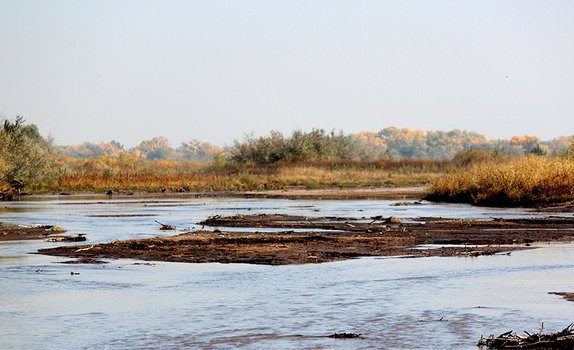
"Night and day the river flows. If time is the mind of space, the river is the soul of the desert." -Edward Abbey, The Hidden Canyon.
Speaking our river’s name, the Rio Grande, evokes images of a vast and powerful river of the West, flowing forth from high mountains through the desert landscape nurturing an abundance of life that springs forth along its banks. The river is truly the soul of this desert community, offering opportunities for life, growth, and co-creation in an otherwise severe and less than hospitable environment. Human settlements have flourished for centuries along the banks of the Rio Grande with thriving agricultural communities supported by the waters of this great river. In the middle of the Rio Grande basin is the city of Albuquerque, which hosts the largest population along the river’s 3,051 km journey to the sea. Stretched out for miles in every direction from the river’s shores, Albuquerque and its population have greater needs than the river can support. Albuquerque’s human development sprawls to the horizons in a concrete maze of roads, houses, shopping centers, airports, industrial parks, which drain the river’s scarce surface and interconnected groundwater supplies.
As a result of the pressure that humans place on the river, many non-human animal species that rely on the Rio Grande are stressed to the brink of extinction. Enforcement of provisions of the Endangered Species Act (ESA) has kept state water managers from running the river completely dry, and credit for the enforcement of this law belongs to the 501(C)(3)non-profit organization known as WildEarth Guardians. Based in Santa Fe, NM, this organization uses litigation and on-the-ground intervention tactics to help protect our endangered river and the many species that it supports. For example, this past summer WildEarth Guardians filed suit in federal court against the U.S. Bureau of Reclamation and U.S. Army Corps of Engineers for declaratory and injunctive relief in response to the water managers’ failure to secure dynamic and perennial flows for the Rio Grande.
An article in the Santa Fe Reporter by Laura Paskus published September 16, 2014 described the state’s response to legal action that WildEarth Guardians had taken to protect the silvery minnow:
During September’s drying, the Bureau of Reclamation released a small amount of water—about 50 cubic feet per second—from storage for the endangered Rio Grande silvery minnow…But more than 20 miles of the river still dried within two stretches south of Albuquerque. The drying sends biologists back out to “salvage” any live minnows they can find in puddles, then bring them to a flowing stretch of the river. Despite efforts to salvage minnows in the summer and stock them in the fall, their population is as fragile as it’s ever been.
It is disturbing that our region’s relationship to the Rio Grande has been reduced to battling over desperate and short-term measures to save the river and all life that depends on it for survival. Are decades of involvement in ESA litigation the only way to keep the river flowing? Are the last-ditch efforts by biologists who are slogging through mud to rescue the few remaining survivors of an imperiled species truly the best means of resuscitating the river? We are inextricably tied to this imperiled river of life. We need this river, and today the river needs us. Instituting laws that require the maintenance of instream flows within the Rio Grande would be a strong step towards protecting the river’s future. Mandates for maintaining minimum instream flows have been implemented in other Western states and help to ensure that there is water allotted to sustain wildlife, water quality, fisheries and recreation uses. New Mexico could apply alternate interpretations of existing laws to support the command for sustaining instream flows. For example, the Prior Appropriation doctrine principal rule of "first in time, first in right" could be applied to appeal for the Rio Grande’s first right to its own water.
For all that the river has provided to us, we should take a stand as a community to act as stewards of this endangered lifeline. The state of the endangered silvery minnow, once the most abundant fish in the river, is an indicator of the compromised state of the health of the river. If our river dries up and its connected ecosystems die off, then the support system for the human population that has grown here will crumble, and we too will be extirpated from this area. As a community that was born out of the waterways and rich alluvial soil of the Rio Grande Basin, we have a moral obligation to protect this river. Collectively and individually, we are obligated to hold ourselves, our water managers and government accountable for the appropriate use and stewardship of our river.
(Photo by the City of Albuquerque / CC)



Responses to “The Rio Grande - Our Imperiled Lifeline”